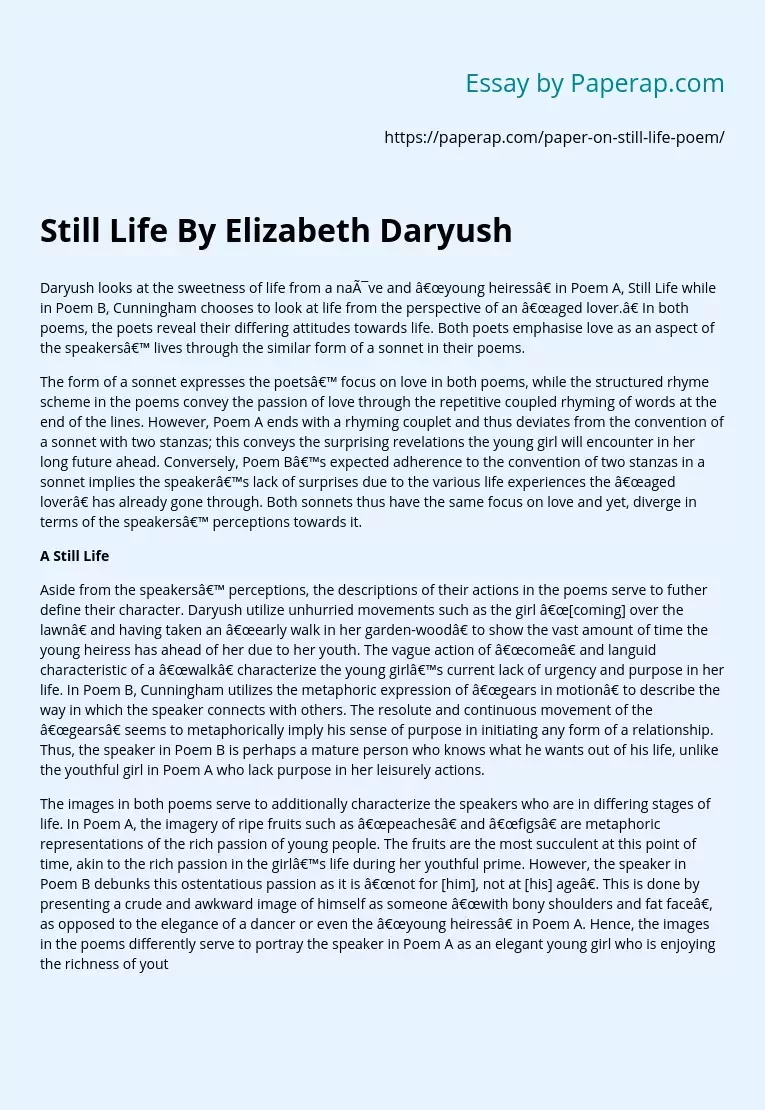Daryush looks at the sweetness of life from a naïve and “young heiress” in Poem A, Still Life while in Poem B, Cunningham chooses to look at life from the perspective of an “aged lover.” In both poems, the poets reveal their differing attitudes towards life. Both poets emphasise love as an aspect of the speakers’ lives through the similar form of a sonnet in their poems.
The form of a sonnet expresses the poets’ focus on love in both poems, while the structured rhyme scheme in the poems convey the passion of love through the repetitive coupled rhyming of words at the end of the lines.
However, Poem A ends with a rhyming couplet and thus deviates from the convention of a sonnet with two stanzas; this conveys the surprising revelations the young girl will encounter in her long future ahead. Conversely, Poem B’s expected adherence to the convention of two stanzas in a sonnet implies the speaker’s lack of surprises due to the various life experiences the “aged lover” has already gone through.
Both sonnets thus have the same focus on love and yet, diverge in terms of the speakers’ perceptions towards it.
A Still Life
Aside from the speakers’ perceptions, the descriptions of their actions in the poems serve to futher define their character. Daryush utilize unhurried movements such as the girl “[coming] over the lawn” and having taken an “early walk in her garden-wood” to show the vast amount of time the young heiress has ahead of her due to her youth.
The vague action of “come” and languid characteristic of a “walk” characterize the young girl’s current lack of urgency and purpose in her life. In Poem B, Cunningham utilizes the metaphoric expression of “gears in motion” to describe the way in which the speaker connects with others. The resolute and continuous movement of the “gears” seems to metaphorically imply his sense of purpose in initiating any form of a relationship. Thus, the speaker in Poem B is perhaps a mature person who knows what he wants out of his life, unlike the youthful girl in Poem A who lack purpose in her leisurely actions.
The images in both poems serve to additionally characterize the speakers who are in differing stages of life. In Poem A, the imagery of ripe fruits such as “peaches” and “figs” are metaphoric representations of the rich passion of young people. The fruits are the most succulent at this point of time, akin to the rich passion in the girl’s life during her youthful prime. However, the speaker in Poem B debunks this ostentatious passion as it is “not for [him], not at [his] age”. This is done by presenting a crude and awkward image of himself as someone “with bony shoulders and fat face”, as opposed to the elegance of a dancer or even the “young heiress” in Poem A. Hence, the images in the poems differently serve to portray the speaker in Poem A as an elegant young girl who is enjoying the richness of youth while the speaker in B is implicitly characterized as a “clumsy” and “aged” person who does not engage in the passionate notions of young people.
Finally, the enjambment and diction used in the last two lines of both poems hint at the possibility of complications in the speakers’ lives. In Poem A, the enjambment in line 13 emphasise the double denotations of the word “lies”. The pun causes the word to have a sinister subtextual meaning to it, perhaps implying the unpleasant realities of the future the naïve young heiress is venturing into.
Similarly in line 13 of Poem B, the enjambment converges attention on the word “conspires”, which has an equally ominous connotation as “lies”. In the context of Poem B, the speaker may be criticizing the greed of people who wish to be “at once together and alone” and the paradoxical meaning leaves an ominous open-ended conclusion for the reader to speculate about the speaker’s accumulated life experiences with self-centered lovers. Hence, the disturbing connotations of the diction used results in ambiguity and speculation about the potential life experiences of the speakers in both poems.
The speakers in both poems undoubtedly differ in terms of personality or even physical attributes, but both poets utilize similar devices to characterise the speakers. Through the characterization of the innately dissimilar speakers, the poets reveal different perceptions on life. Both poets utilize ambiguity and perhaps end off with a slight sense of foreboding, inviting speculation from the reader about the possibilities of betrayal or obstacles in the course of one’s life.
Still Life By Elizabeth Daryush. (2019, Dec 05). Retrieved from https://paperap.com/paper-on-still-life-poem/

